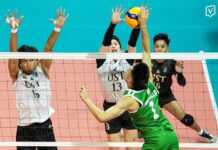ALL OF a sudden, Johannesburg, South Africa has become the most popular place in the world.
Football fever is all over as the 2010 Fédération Internationale de Football Association (FIFA) World Cup took center stage last June 11 as the most widely viewed sporting event in the world – except for Filipinos.
In the Philippines, FIFA has a limited reception in terms of viewership compared to the National Basketball Association (NBA) championship series between the Los Angeles Lakers and Boston Celtics. From professionals to students, tricycle and jeepney drivers to the ordinary man on the streets—everyone seemed to have followed NBA.
Jose Ariston Caslib, technical director of the Philippine Football Federation (PFF), said that although the sport was developing in the country, the progress was slow and unstable, and must therefore be sustained.
He said the popularity of Philippine football could not be on the same level as that of basketball because the latter was the darling of the media, hands down.
“We cannot compare with basketball right now,” he said. “(It has) the attention of the tri-media group, so we’re very far.”
UST Golden Booters coach Marjo Allado said likewise, that the sport’s popularity was diminished because of the absence of professional premier competitions such as the Philippine Basketball League and Philippine Basketball Association, as compared to the heydays of the sport in the 1970’s and 80’s.
“Let’s say you’re a varsity player, a member of the national team. After you graduate, you’ll have no place to go since there’s no professional league. What will happen is that you’ll just go look for work,” he said.
Caslib said that the PFF was not yet focused on running a national league but the federation recently formed a committee to develop a Luzon-wide tournament.
“There are initiatives to have a league but then these people must observe what the technical and the non-technical needs of a league are,” he said.
Football also faces the biggest obstacle of most sports in the Philippines: funding constraints worsened by leadership issues between national sport associations and the Philippine Sports Commission.
Despite receiving donations from the private sector and a $250,000 annual support from FIFA as part of its “Goal Programme,” the country still could not run a football program with such an amount, Caslib said.
“In order for the Philippines to run a football program, it needs P60-80 million in one year. And that’s even a conservative budget to have a complete football development program in all aspects of football,” he said.
Some of the development programs by PFF are in the grassroots level, subsidizing local football associations, especially in Mindanao, and providing budget for competitions within the age bracket of 14 years old and below. They also promote girls’ competition aside from the men’s and women’s event. Because there are no legitimate national leagues in the country, leagues are usually sponsored by local, regional or private sector oftentimes by companies with owners who are football fanatics.
UAAP Football and the UST football community
Football has been among the list of sporting events in the UAAP since it was introduced in 1938.
For almost 15 years of playing and coaching for UST in UAAP, Allado observed that the students’ interest in football today has become low, compared to that of the previous seasons. The number of students who watch the football games, usually held in Ateneo de Manila University field, really depends on which team is playing.
“[The audience] depends on whose team you are playing against. During the championship, there is a bigger audience if you’re against Ateneo or La Salle. But if you’re playing against UE or FEU, there is less,” said Allado, who started playing for UST in 1995.
Thomasians, through the Thomasian Goodwill Games, developed their interest and love for the sport.
“In truth, the intramural championship [here in UST] is more watched than the UAAP. If you will compare the UST football community to other universities, we are number one, because there are a lot of football players here, every college,” Allado said.
Football for the Filipinos
The likes of Filipino power striker Paulino Alcantara has disappeared in the memory of this basketball-crazy country. From the football bailiwick of Visayas, with an astonishing string of 357 goals, Alcantara still holds the goal scoring record when he played his glory years from 1912 to 1927 with the Barcelona Football Club, David Beckham’s former squad. He is in fact the first Asian and the first Filipino to play in a European football club. He did so when he was just 15 years old, making him the youngest player to don the jersey and score in the said team.
Although Filipinos do not seem to care much about running in the fields while kicking some black-and-white ball, we may be looking forward to a wrong goal since Filipinos are naturally gifted with a built somewhat more fit to play football than basketball.
“There are many Filipinos who want to play football because it caters to Filipinos when it comes to their built. It is not like basketball that requires height. Even though you’re not tall, if you’re footwork is good, you’ll turn out better than those who are taller,” said Allado.
The average Filipino height is only 5”4,’ too short to be at par with top playing Americans and other races who are much taller. Though we are at a losing end at basketball with the liability of our height, this may be something we can capitalize on in the field of football.
“Basketball has not really reached its potential here in the country. It’s been stagnant for the last 20 years already. I think reality has shown that we cannot really dominate basketball. Football must take the initiative,” Caslib said.

















